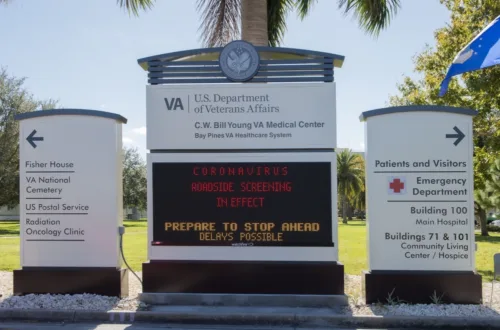Study: Forever Chemicals Linked to Cancer Among Troops

A study published on the National Institute for Health official site links “forever chemicals” to testicular cancer among some military members.
The study says some troops have an elevated risk of cancer due to a group of substances commonly known as PFAS, which are used in a variety of applications, including military firefighting operations where PFAS are found in firefighting foam.
Forever Chemical Study
The forever chemical study, titled, A Nested Case-Control Study of Serum Per- and Polyfluoroalkyl Substances and Testicular Germ Cell Tumors among U.S. Air Force Servicemen, saw researchers at the National Cancer Institute examing blood samples from Air Force members to study levels of PFAS forever chemicals.
Researchers found “strong evidence that airmen who were firefighters had elevated levels of PFAS in their bloodstreams and weaker evidence for those who lived on installations with high levels of PFAS in the drinking water,” according to the study. Another finding: Airmen with testicular cancer had higher levels of forever chemicals than those who were not similarly diagnosed.
The study included 530 cases and 530 controls, “individually matched on birth date, race and ethnicity, year entered the service, and year of sample collection, with prediagnostic serum samples collected between 1988 and 2017,” according to the study.
Congressional Mandate to Stop Using Forever Chemicals
Congress requires the DoD to stop using firefighting foam with forever chemicals by October 2024. One news outlet reporting on this study noted that the DoD is, despite that requirement, allowed to continue the purchase of firefighting foam that does contain forever chemicals until October 2023.
Some published reports note that some may have been given bad information about the nature of the firefighting foam currently used, that it is no more harmful than “soap and water.” Kaiser Health News reports, ‘Photos released by the Defense Visual Information Distribution Service in 2013 show personnel working in the foam without protective gear.”
Kaiser Health News notes the official descriptions of the photographs released at the time include noting a “small sea of fire retardant foam” at Travis Air Force Base in California described as “non-hazardous” and “similar to soap.”
How Long Has DoD Known About Forever Chemicals?
The United States military may have known about the harmful effects of PFAS for much longer than some realize. Kaiser Health News reports the DoD may have had early warning about PFAS danger in 1974 when a DoD study published then noted the chemicals are toxic to marine life.
In 1983 the Air Force released a technical report said to demonstrate the dangers of PFAS forever chemicals to mice. Despite this, the use of forever chemicals in military firefighting programs would continue until the ban in October 2024.
Effects of Forever Chemical Exposure
The VA official site notes, “PFAS can be found throughout the world and most people have been exposed at low levels.” The agency believes more research is needed to understand the connections between medical issues and PFAS exposure.
The Agency for Toxic Substances and Disease Registry suggests that PFAS/forever chemical exposure could be a factor in the following medical issues:
- Fertility issues
- Pregnancy-induced hypertension/preeclampsia
- Increased cholesterol
- Changes in the immune system
- Increased risk of certain cancers (e.g., testicular and kidney cancer)
- Changes in fetal and child development
- Liver damage
- Increased risk of thyroid disease
- Increased risk of asthma
Future Legislation Against PFAS?
Some lawmakers propose more legislation to address PFAS and forever chemicals among the troops.
In June 2023, one lawmaker introduced the Veterans Exposed to Toxic PFAS Act, which, if passed, would require the VA to treat conditions linked to PFAS exposure.
Another law, the PFAS Exposure Assessment and Documentation Act, would require the federal government to provide testing for all service members assigned to duty stations with known PFAS issues.
What’s Next?
The Department of Veterans Affairs encourages all concerned about PFAS exposure to discuss their concerns with a VA Environmental Health coordinator and their primary care provider.
Some may feel strongly about getting certain kinds of tests, but the Department of Veterans Affairs advises caution.
The VA, at press time, has the following statement on its official page about filing VA claims for forever chemical exposure:
“VA does not recommend blood tests to determine levels of PFAS in any individual. This is because most people in the U.S. have measurable amounts of PFAS in their blood and normal ranges have not been established.” The VA adds that blood tests “cannot be linked to current or future health conditions or guide medical treatment decisions.”
The VA does encourage those who may have been exposed to PFAS to file a claim with the agency.
“Veterans may file a claim for disability compensation for health problems they believe are related to exposure to chemicals during military service. VA decides these claims on a case-by-case basis.”
About the author
Editor-in-Chief Joe Wallace is a 13-year veteran of the United States Air Force and a former reporter/editor for Air Force Television News and the Pentagon Channel. His freelance work includes contract work for Motorola, VALoans.com, and Credit Karma. He is co-founder of Dim Art House in Springfield, Illinois, and spends his non-writing time as an abstract painter, independent publisher, and occasional filmmaker.


